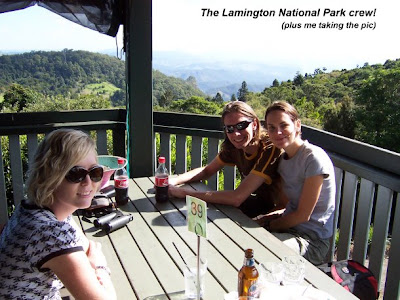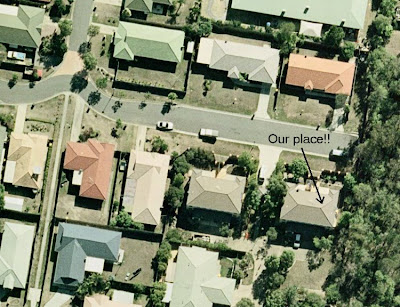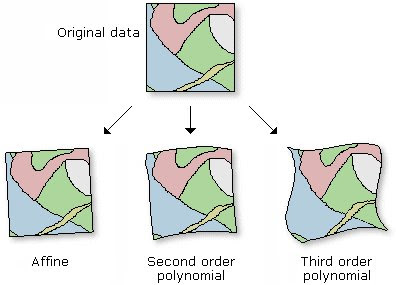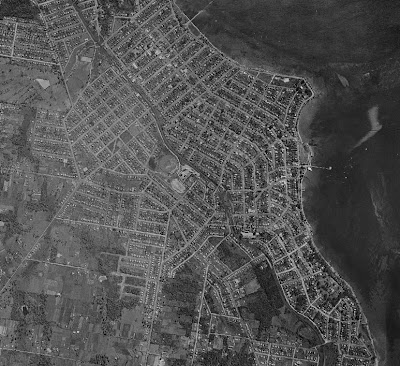 Between the 1st and 7th June 2009, I was lucky enough to travel to Cairns and the surrounding areas for a bird-watching trip. I travelled with two friends from Perth; Ryan Phillips and Myles Menz (the last of whom I actually met on the trip). We hired a 4-berth campervan called “The Warrior”, that was surprisingly roomy and comfortable to drive. HOWEVER, living in very close proximity with two other males is a challenge at the best of times, little alone when one of them leaves random underwear strewn around the van!
Between the 1st and 7th June 2009, I was lucky enough to travel to Cairns and the surrounding areas for a bird-watching trip. I travelled with two friends from Perth; Ryan Phillips and Myles Menz (the last of whom I actually met on the trip). We hired a 4-berth campervan called “The Warrior”, that was surprisingly roomy and comfortable to drive. HOWEVER, living in very close proximity with two other males is a challenge at the best of times, little alone when one of them leaves random underwear strewn around the van!That aside, it was a fantastic trip with an amazing 175 species of birds, including all of the Atherton Tableland endemics. Of the 175 species, 51 of them were new for me; including 3 new species of robins; Grey-headed Robin, Lemon-bellied Flycatcher and Mangrove Robin! The particular highlights of the trip, apart from the robins, included seeing many of the north-Queensland endemics such as the Southern Cassowary, Golden Bowerbird and Fernwren. The Golden Bowerbird took quite some effort to see, and involved us walking 8km up the Mt Lewis road. Although we didn’t see any spectacularly coloured males, we saw 6 – 7 females! The following is a list of all the species I saw on the trip, and particular notes on particular species of note or interest! New species for me are also shown! Please also see the new Cairns birdwatching holiday photo album on the right panel.
Pacific Black Duck
Eastern Reef Egret
Cattle Egret
Great Egret
Australian White Ibis
Straw-necked Ibis
Royal Spoonbill
Ruddy Turnstone
Bar-tailed Godwit
Red-necked Stint
Masked Lapwing
Red-capped Plover
Black-fronted Dotterel
Silver Gull
Laughing Gull – NEW – rare vagrant to Australia, although there was a juvenile sitting out on the Esplanade amongst Silver Gulls.
Gull-billed Tern
Pacific Baza – saw 3 of them together calling raucously around Mareeba Wetlands.
White-bellied Sea Eagle
Australian Kestrel
Black Kite
Topknot Pigeon – huge numbers of them circling around Malanda Falls.
Brown Cuckoo-dove
Peaceful Dove
Bar-shouldered Dove
Spotted Turtle-dove
Crested Pigeon
White-headed Pigeon
Emerald Dove – NEW – What an amazing coloured little dove this is…. lovely.
Double-eyed Fig Parrot – NEW – managed to glimpse a couple on the Daintree River cruise, actually excavating a nest hollow. Apparently, this is one of only 2 – 3 species in Australia that excavate nest hollows from scratch!?
Scaly-breasted Lorikeet
Rainbow Lorikeet
Australian Swiftlet – NEW
Laughing Kookaburra
Collared Kingfisher
Forest Kingfisher
Rainbow Bee-eater
White-throated Treecreeper – saw this up with our tour guide ‘Chook’ at Mareeba Wetlands. The subspecies of the treecreeper up here (subspecies minor) looks totally different from the southern sub-species; being much smaller and darker.
Red-backed Fairy-wren
Striated Pardalote
Large-billed Scrubwren
Brown Gerygone
Lewin's Honeyeater
White-throated Honeyeater
Brown Honeyeater
Scarlet Honeyeater
Dusky Honeyeater – NEW – common around the gardens of Lake Barrine
Eastern Whipbird
Pale-yellow Robin
Grey headed Robin – NEW – saw in a number of rainforest locations on the Atherton Tableland. A big species of robin this one!!
Golden Whistler
Willie Wagtail
Yellow-breasted Boatbill – NEW – Very cute little species; surprisingly colourful little fella
Pied Monarch – NEW – I’ve wanted to see these species for a long time!
Magpie Lark
Spangled Drongo
Australasian Figbird
Victoria's Riflebird – NEW – Saw a male and many females in the carpark of Lake Barrine – too easy!!
Green Catbird – Although this is not a new species for me, the Green Catbird up this way is a distinct subspecies (race actually) known commonly as the Spotted Catbird. It is distinctly different from the southern populations of Green Catbird, and probably deserves to be a separate species.
Toothbill Bowerbird - NEW
Black-faced Cuckoo-shrike
White-breasted Woodswallow – sexiest of the woodswallows!
House Sparrow
Red-browed Firetail
Yellow-bellied Sunbird
Common Myna
Little Black Cormorant
Australasian Grebe
Orange-footed Scrubfowl – NEW – walking around the Malanda Caravan Park grounds that we were staying in!
Magpie Goose – NEW – saw them previously however in Stephen Davies’ backyard in Mt Helena in Perth, although obviously, these were a captive population!
Plumed Whistling Duck – NEW – Hundreds of them in Hasting’s Swamp, along with Magpie Geese!!
Hardhead
Intermediate Egret – NEW – First confirmed identification of these for me, usually just assume Great Egret!
Sarus Crane – NEW - Awesome flight display on the Tablelands near Upper Barron.
Black-shouldered Kite
Whistling Kite
Brown Goshawk
Spotted Harrier – NEW – First look at this species at it hovered low over the Tablelands!
Australian King Parrot
Sulphur-crested Cockatoo
Fan-tailed Cuckoo
Yellow-throated Scrubwren
Mountain Thornbill – NEW – One of the North-Queensland rainforest endemics
Welcome Swallow
White-cheeked Honeyeater
Eastern Yellow Robin
Little Shrike-thrush – NEW – Hard to tell from the Bower’s Shrike-thrush, although slightly smaller, and different face colour.
Grey Fantail
Spectacled Monarch – NEW – FINALLY seen one of these, even though they are found down near Brisbane!
Satin Bowerbird
Pied Butcherbird
Australian Magpie
Pied Currawong
Torresian Crow
Tree Martin
Chestnut-breasted Mannikin
Silvereye
Mistletoebird
Little Pied Cormorant
Wandering Whistling-duck
Grey Teal
Wood Duck
Dusky Moorhen
Eurasian Coot
Grey Goshawk
White-throated Gerygone
Helmeted Friarbird – NEW – This really is an ugly species
Macleay's Honyeater – NEW – What a stunningly beautifully coloured bird; seen at Lake Eacham feeding on the Umbrella Palms.
Yellow-spotted Honeyeater – NEW – rather hard to identify sometimes from Lewin’s Honeyeater, although the former is slightly smaller and has a darker face
Bridled Honeyeater – NEW
Yellow Honeyeater
Eastern Spinebill
Chowchilla – NEW – Saw along the road into Mt Hypipamee Crater; needless to say, you need to be patient and very still to see them. Also saw them up Mt Lewis, and this most likely represents a unique subspecies.
Bower's Shrike-thrush – NEW – Another highly restricted North-Queensland Rainforest endemic
Barred Cuckoo-shrike – NEW – Seen in the main street of Yungaburra; spectacularly bright yellow eye!!
Australasian Pipit
Golden-headed Cisticola – NEW – Finally seen this species in all it’s glory now; no fleeting glimpse, but a prolonged look!
Pheasant Coucal
Emu
Darter
Pied Cormorant
Black Swan
Green Pygmy Goose – NEW – At Mareeba Wetlands
Black-necked Stork
Comb-crested Jacana – NEW – At Mareeba Wetlands
Brown Falcon
Rock Dove
Wompoo Fruit-dove – NEW – Saw this species down on the ground at Julatten Birdwatchers Lodge, so an awesome look at this very colourful dove
Squatter Pigeon – NEW – At Mareeba Wetlands
Red-tailed Black Cockatoo
Shining Bronze-cuckoo
Azure Kingfisher – zipping along the watercourse at Julatten
Red-backed Kingfisher
Brown Treecreeper
Weebill
Noisy Friarbird
Blue-faced Honeyeater
Graceful Honeyeater – NEW – On the road up Mt Lewis
White-naped Honeyeater
Grey-crowned Babbler
Lemon-bellied Flycatcher – NEW – Totally unexpected species on this trip. Seen in the woodlands at Mareeba Wetlands. For those not in the know, this is actually a species of Australian robin, so needless to say, I was rather excited.
Rufous Fantail
Leaden Flycatcher
Great Bowerbird
White-bellied Cuckoo-shrike - NEW
Varied Triller – NEW
Fairy Martin
Rufous Songlark
Clamorous Reed Warbler
Double-barred Finch
Common Starling
Chestnut-breasted Cuckoo – NEW
Lesser Sooty Owl – Although this was a new species for me, I haven’t officially listed it, as we only saw one flying through the campground in Julatten
Masked Owl – NEW – FANTASTIC views of two emerging from hollows at Julatten. We were guaranteed views by the caretakers, and they didn’t disappoint!
Papuan Frogmouth – NEW – Great views in Julatten and again on the Daintree River.
Blue-winged Kookaburra
Fernwren – NEW – Fleeting glimpse of them along the Mt Lewis track
Bush Stone-curlew
Atherton Scrubwren – NEW – needless to say, an Atherton Tableland endemic
Fairy Gerygone – NEW – seen along the Daintree River shoreline
Yellow-faced Honeyeater
Grey Whistler – NEW – another seen along the Daintree River shoreline
Golden Bowerbird – NEW – this was probably the highlight of the trip. We saw 6-7 females in all, 8km up the Mt Lewis track, that we travelled on foot! VERY geographically restricted species that is one of the most threatened by climate change due to it being found only in tropical rainforest above 900m altitude.
Rufous Night Heron
Sacred Kingfisher
Large-billed Gerygone – NEW – Found along the Daintree River shoreline
Rufous Whistler
Shining Flycatcher – NEW – Stunning slate colour, seen along Daintree River
Yellow Oriole – NEW – another species found on the Daintree
Metallic Starling – NEW – very unexpected species that we didn’t expect this time of the year; they were most likely juveniles that didn’t migrate north
Southern Cassowary – NEW – iconic species that we were lucky to see up near Cape Tribulation crossing the road with two young!
Beach Stone-curlew – NEW – found, funnily enough, on the beach
Crested Tern
Lovely Fairy-wren – NEW – rather large fairy-wren seen on the drive out of the Cape Tribulation campground
Mangrove Robin – NEW – final species of the trip seen on the Mangrove walk near the Cairns Airport!! Been wanting to see these for years… great new species, being a robin and all!!
Black Butcherbird

































 We have been harvesting basil pretty much since day 1, and only harvested our first capsicum 2 days ago to have (with the freshly picked basil) on home-made pizzas!
We have been harvesting basil pretty much since day 1, and only harvested our first capsicum 2 days ago to have (with the freshly picked basil) on home-made pizzas!














